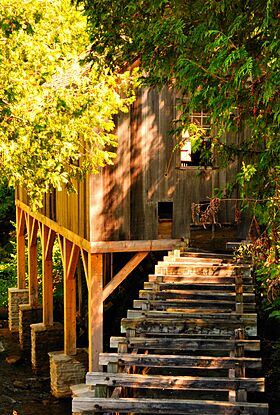Historic Mill Creek Discovery Park facts for kids
Quick facts for kids Historic Mill Creek |
|
|---|---|

The historic sawmill
|
|
| Lua error in Module:Location_map at line 420: attempt to index field 'wikibase' (a nil value). | |
| Location | Mackinaw Township, Cheboygan County, Michigan, United States |
| Nearest city | Mackinaw City, Michigan |
| Area | 625 acres (2.5 km²) |
| Established | 1984 |
| Administered by | Michigan Department of Natural Resources Mackinac Island State Park Commission |
| Website | |
|
Campbell Farm Site
|
|
| Area | 6 acres (2.4 ha) |
| NRHP reference No. | 78001496 |
| Significant dates | |
| Added to NRHP | January 31, 1978 |
Historic Mill Creek is a special place in Michigan. It is a state park, a nature preserve, and a historic site all in one. The park is managed by Mackinac State Historic Parks. This group also runs the Mackinac Island State Park.
Historic Mill Creek covers 625 acres (about 2.5 square kilometers). You can find it about 5 miles (8 kilometers) southeast of Mackinaw City, Michigan. It is located right on U.S. Highway 23.
Contents
A Look Back: The History of Mill Creek
Building the First Sawmill
The first sawmill at Mill Creek started working around 1790. It kept running until 1839. A man named Robert Campbell built this mill. Its main job was to provide lumber for the Straits of Mackinac. This area included the growing settlement of Mackinac Island.
In 1793, the sawmill helped Fort Mackinac. It provided wood to fix the soldiers' barracks. The Mill Creek sawmill was very important for lumber in the Straits of Mackinac. This was during the time when trading animal furs was a big business.
Life at the Mill
Around 1820, a house was built near the sawmill. This was for the millwright, who was the person who operated and maintained the mill. In 1819, Michael Dousman bought the mill. He continued to run it for many years.
However, the demand for beaver fur started to drop in the 1830s. After Michael Dousman passed away in 1839, the sawmill and the millwright's house were left empty. Over time, the buildings fell apart and disappeared.
Bringing the Past Back to Life
Even though the original buildings were gone, some of the wood cut by the mill survived. This wood was used in buildings on Mackinac Island. Examples include the Mission Church and Mission House. These buildings were constructed in the 1820s and are still standing today.
Experts studied the saw marks on these old timbers. These marks helped them figure out how the original mill machinery worked. They learned about the saw's teeth and how fast it operated. This information was key to rebuilding the sawmill to look just like it did long ago.
In the 1970s, archaeologists dug up the sawmill site. They called it the "Campbell Farm Site." This helped them learn even more about the mill's history.
Mill Creek Today: What You Can See and Do
Exploring the Park's Natural Beauty
Mill Creek flows from the Dingman Marsh. This is a special wetland inside the Mackinaw State Forest. Historic Mill Creek Discovery Park includes about 1 mile (1.6 kilometers) of the creek. The creek flows downhill towards Lake Huron.
The park has rebuilt many of its historic structures. The creek dam and sawmill were rebuilt in 1984. The sawmill was updated again in 2007. The British Workshop, which dates back to about 1820, was rebuilt around 1994. The millwright's house, also from about 1820, was rebuilt in 2005.
Fun Activities and Things to Learn
Historic Mill Creek offers 3.5 miles (5.6 kilometers) of nature trails. About 1.5 miles (2.4 kilometers) of these trails are easy for everyone to use.
In the summer, you can see people dressed in old-fashioned clothes. They use tools from the 1820s to make things like shingles. They also show how the sawpit and sawmill used to work. A park naturalist gives talks about the animals and plants that live in the nearby forests.
The North Central State Trail also connects to Historic Mill Creek State Park. It's a great place to visit and learn about history and nature!

